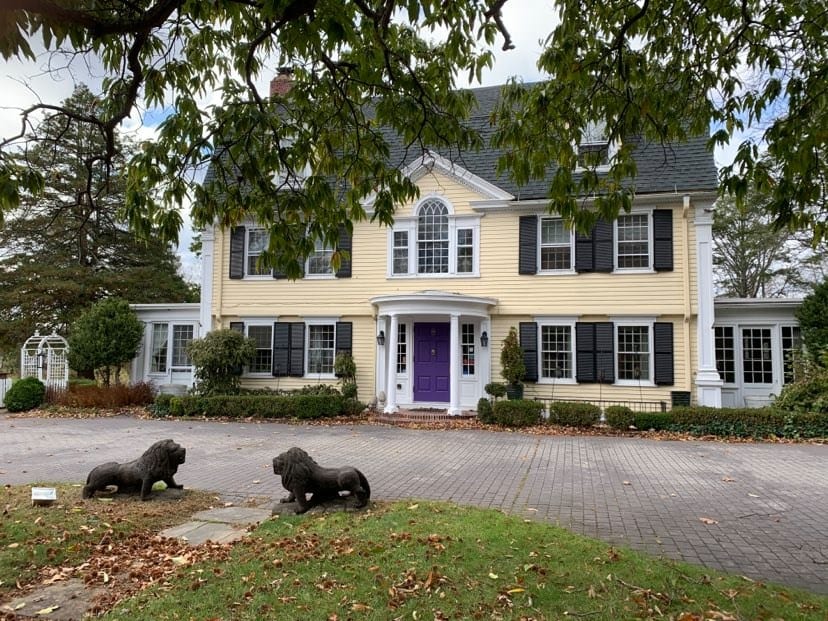OLD LYME — The Zoning Commission has approved a special permit application for the Roger Tory Peterson Estuary Center to relocate to 100 Lyme Street, the current location of the Bee and Thistle Inn.
At its virtual meeting Monday night, the commission approved a special permit application and municipal coastal site plan review application to permit the use of the property for nonprofit and educational activities.
Claudia Weicker, the center’s board chair, said a condition of the purchase agreement of the inn was approval of the special permit application before the end of the year, which Weicker said was the inn owner’s desire.
The 10,000-square-foot inn, built in 1756, will replace the center’s 1,600-square foot space at 90 Halls Road. Two Jacks LLC purchased the property for $1.575 million in 2006. Weicker has not named the sale price but has said the organization is raising $5.6 million for the purchase, maintenance and operations of the property and that phased renovations are planned for the following 24 to 36 months.
Attorney Michael Cronin, who represented the nonprofit, which is part of the Connecticut Audubon Society, said application for special use fell under the town’s 5.2.3 regulation, specifying “philanthropic, educational, recreational or religious non-residential use by a duly organized non-profit entity or governmental unit, excluding correctional institutions and institutions for the insane.”

In a presentation to the commission, engineer Robert Doane, of Centerbrook, said the new use of the 5.3-acre site technically required 70 parking spaces. He said there was room currently to fit 31 spaces and that the remaining 49 spaces — which he said were not needed, at least not immediately — could be constructed more than 100 feet away from inland wetlands and the tidal wetlands on the property.
The Coastal Area Management application was submitted to the Department of Energy and Environmental Protection and received a favorable review with public access as a potential issue, said Doane.
“The only issue —and we’re dealing with coastal waters — is that we do not want to preclude a use of the site for a water dependent use. I expressed in the Coastal Area Management application that I feel that the Roger Tory Peterson Estuary Center is essentially a water dependent use because of the educational aspect of the center,” he said. “There is not a better location that I can think of other than this site. It has wetlands, it has tidal wetlands, it has the Lieutenant River, all of which fits very nicely into the mission of the center”
Commission Chair Paul Orzel read aloud part of a letter from Marcy Balint, Senior Coastal Planner Land and Water Resources Division of the Connecticut Department of Energy and Environmental Protection.
“We know for the record that the provision of public access at this site is consistent with water dependent use policies of the CCMA [Connecticut Coastal Management Act], which requires boards and committees to give priority consideration to such uses at waterfront sites and includes public access by definition,” wrote Balint. “We recommend the public access at the site be a condition of Coastal Site Plan Review (CSPR) approval to assure CCMA consistency into the future.”
Cronin said the facility will “significantly contribute to the public access to a coastal marine environment,” but that the property “really wasn’t designed to put in something like a public boat launch or a public dock.”
“The primary mission of this organization is going to be education. There’ll be a lot of people on the property, young people. There will be issues of security, there will be issues of reliability,” he said. “Of course, you’re a private organization, you don’t have the general protections for these kind of facilities that municipalities or the state have.”
Doane said the septic system can handle nearly twice the anticipated amount of effluent. He said Ledge Light Health District provided a letter stating that the septic system was adequate for described use but may require additional approvals if the use is expanded.
He said the commission had also received a letter from town engineer Tom Metcalf stating that the plan is “acceptable from an engineering perspective.”
In a letter to the commission, Dave Roberge, fire marshal for the town, raised the question of the four-bedroom cottage on the property, which would require a special approval for residential use. Cronin said eventually the center would like to use the space for visiting scientists or interns but acknowledged it would require a separate application for residential use.
The project was approved with four conditions outlined by Jane Marsh, secretary of the commission. First was a waiver of a traffic study because the new use will provide a reduction in traffic. Second, the 49 additional parking spaces are deferred until deemed necessary by the Zoning Enforcement Officer acting on behalf of the Zoning Commission or the applicant.
“Number three, we will find that the water dependent use as stated by the applicant is deemed sufficient because of the public nature of the applicant and its proposed use,” said Marsh. “And, number four, that no residential uses for the property are approved at this time.”
Weicker said the organization was excited about the property because it offers the opportunity to combine an outdoor “laboratory” of the river and the wetlands with an indoor facility for classes, lectures and workshops.
She said the property is a reminder of the strong bond in Old Lyme between nature and the development of a significant American art movement.
“I find it somewhat hopeful that as we sit here, admittedly virtually, we have the opportunity of creating another place in our town, where people will be able to go to learn about nature, to begin to understand it in a much deeper way, and to find meaning in this world.”

